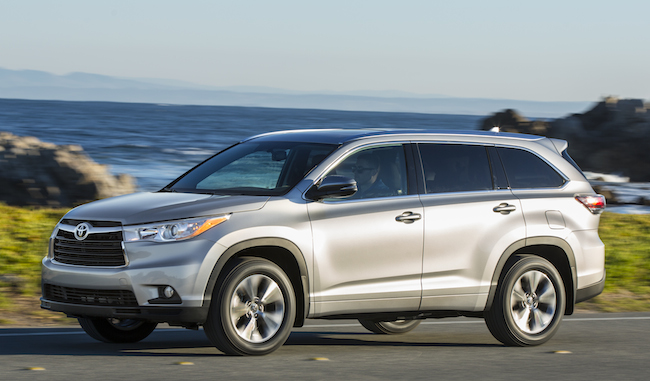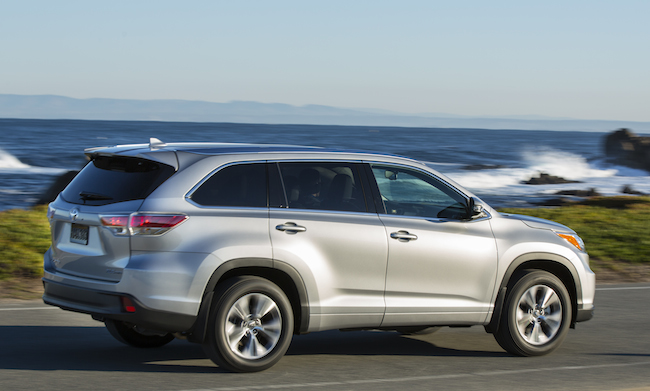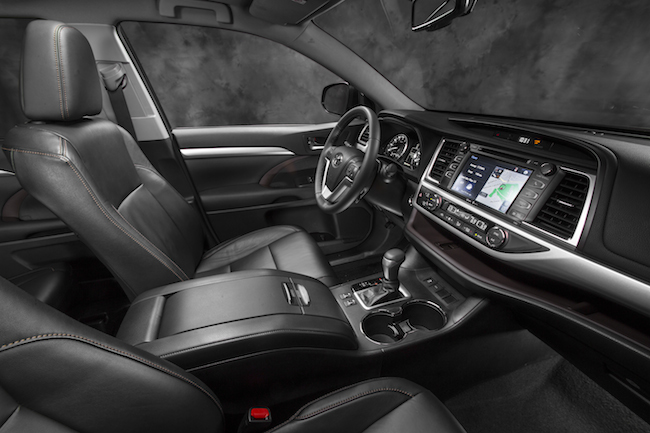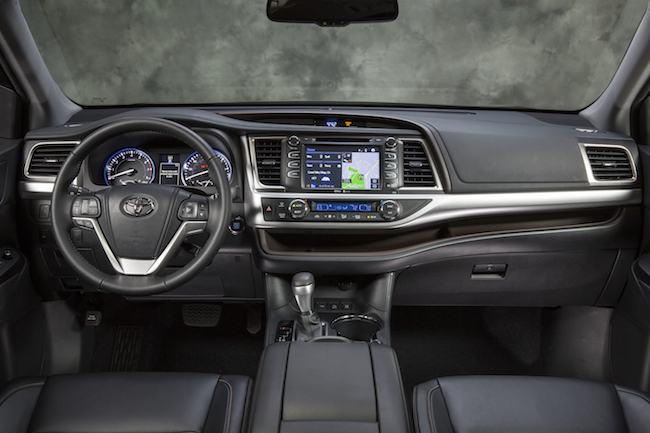2014 Toyota Highlander – Meeting Competition
- December 16, 2013
- New Model Introductions, On The Road: Driving Impressions, Toyota
- Posted by George Peterson
- 1 Comment

 Don’t Call it a “Crossover” Like Ford and other makers, Toyota has largely abandoned the distinction between “traditional” and “crossover” sport utility vehicles. “It was confusing our customers,” said Bill Fay, Group Vice President of the Toyota Brand. Now, Toyota refers to both under the “mid-size sport utility vehicle umbrella”. This might seem to be a small thing, but for decades (at least since 1997 when unibody “crossovers” began appearing) automakers have been making this distinction. The customers largely did not know or care about the difference, they just bought the emerging crossovers in droves.
Don’t Call it a “Crossover” Like Ford and other makers, Toyota has largely abandoned the distinction between “traditional” and “crossover” sport utility vehicles. “It was confusing our customers,” said Bill Fay, Group Vice President of the Toyota Brand. Now, Toyota refers to both under the “mid-size sport utility vehicle umbrella”. This might seem to be a small thing, but for decades (at least since 1997 when unibody “crossovers” began appearing) automakers have been making this distinction. The customers largely did not know or care about the difference, they just bought the emerging crossovers in droves.
Toyota’s Two-Tier Mid-Size SUV Strategy With the introduction of the 2014 Toyota Highlander, Toyota continues with a two tier mid-size SUV strategy. The unibody 8-pasenger Highlander goes into its third generation with the 2014 model year entry in production since early December, 2013. The body-on-frame 4Runner appeals to the traditional SUV buyer needing more off-road capability and towing ability. Fay says, “these are totally different buyers and the 4Runner and Highlander are seldom cross-shopped with each other.
For 2014, the Highlander gets more aggressive styling, a more upscale interior and a price bump of about $1,500. A lot of that price increase is offset by the Highlander having more standard equipment.

 Interior Moves Upscale Toyota’s designers and engineers clearly devoted a lot of attention to the instrument panel. It is a neat piece of automotive sculpture with the most up to date technology. The base vehicle comes with a 6.1-inch touch screen. When you get to the XLE and Limited models an 8-inch touchscreen is fitted.
Interior Moves Upscale Toyota’s designers and engineers clearly devoted a lot of attention to the instrument panel. It is a neat piece of automotive sculpture with the most up to date technology. The base vehicle comes with a 6.1-inch touch screen. When you get to the XLE and Limited models an 8-inch touchscreen is fitted.
A “why didn’t I think of that?” design feature is a shelf running beneath the center stack and below the glove box. This padded shelf is the perfect place to set your smartphone while driving. There is a slot in the shelf that allows a cord to be connected to the USB port to power the phone and connect it to the Toyota Entune app system.
The seat trim is typical Toyota. In leather versions
The feature availability on the Highlander is impressive. Features like adaptive cruise control, cross traffic warning, dynamic grid lines in the rear camera are just a few examples of Highlander (and many other middle- and low-market vehicles) offering features once found only on luxury entries.
Comprehensive Model Offerings There are three basic powertrain offerings for the Highlander. The price-leader LE (about $29,200) 185-horsepower 2.7L DOHC 4-cyinder is perfectly adequate for around town driving in the Sun Belt. If you do not need all wheel drive and don’t need to tow, the 4-cylinder would suffice, but you probably won’t find one at your Toyota store. It will be 5% to 10% of the available Highlanders.
The bread-and-butter Highlander is powered by a 3.5L DOHC V6 making 270-horsepower. This is the engine that about 90% of Highlanders will get. It works sell in front wheel drive (with a good amount of torque steer under full throttle) and is required with all wheel drive (about of 60% of Highlanders will be AWD). The 3.5L DOHC V6 is available on the base LE model for an additional $1,305. Add all wheel drive to the V6 version and you increase the price by another $1,460.
The middle of the lineup includes the LE Plus for $32,740 for the front wheel drive version. The front drive XLE model goes for $36,040 and the Limited goes for $39,640.
Hybrid Tops the Lineup At the top of the line is the Highlander Hybrid making 280-horsepower with its Atkinson cycle 3.5L DOHC V6. The Hybrid is available in the Limited trim level and is priced at $47,300. Driving the Hybrid on the hilly roads around Carmel, California we saw about 30mpg – in line with its rated fuel economy. The throttle effort on the Hybrid was high making it difficult to accelerate with traffic without really getting into it. Maybe that is because Toyota wants you to drive the Hybrid like you have an egg between your foot and the accelerator pedal.
Evolutionary Improvements Meet Competition All-in-all, the 3rd gen Highlander is an evolutionary, but substantial, improvement over its predecessor. Toyota describes the Highlander as “Beyond Hero” in the SUV segment meaning it overachieves when compared to competition. They also describe its development as “without compromise”. It does not meet those lofty phrases, and although there are no WOW factors (with the exception of an absolutely gargantuan front seat center console), it will be a steady seller filling an important slot in Toyota’s lineup. Toyota expects to sell about 140,000 units a year in the USA from its Princeton, Indiana assembly plant while sending another 10,000 to 15,000 overseas to another 20 countries.


1 Comment
The 2014 Toyota Highlander had an exterior redesign that makes it a sporty and smooth flight. The brand new front end of this version tapers onward and features an impressive brand-new grille. The bigger back windows produce a feeling of openness in this automobile and thinner front pillars allow for increased presence.